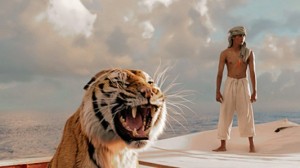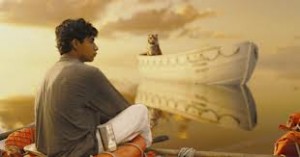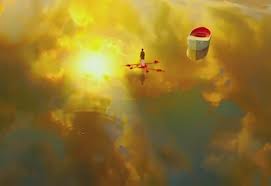
![]()
There are plenty of elements in “Life of Pi” to fill your mind and soul with awe. Stunning locales that come from the stuff of both dreams and nightmares are moved through with a striking use of 3D technology. Many creatures from a huge herd of meerkats to the star of the film, a Bengal tiger named Richard Parker, inhabit this fantasy-fused world. All of these animals share the screen with our hero, Pi, who is played (for the most part as he is seen at several different ages) by newcomer Suraj Sharma. As “Life of Pi” is filled with technical wizardry, it is Sharma’s performance that is the true revelation, the honesty that fills the film with magic.
Based on the award winning novel by Yann Martel, the film covers the amazing story of Pi Patel, an Indian boy whose years on this earth plays much like a fable. As a young child, Pi’s family ran a zoo in the French India on the continent’s Eastern coast. When his father is close to losing the animals because of monetary issues (damn economy), he decides to move his family to Canada sell the animals and get a new start.

While on the voyage to the new world, the cargo boat carrying Pi and his brood sinks plummeting the teenage boy into the ocean with nothing but a small lifeboat stocked with a limited amount of supplies. He is not alone, of course, as he must share the vessel with a Bengal tiger, the aforementioned Richard Parker. Situation moves from bad to worse instantly as Richard Parker is a ferocious animal and does not listen too instruction very easily as Bengal tigers are not known for their balanced reasoning. The relationship between the two is handled perfectly and the bond is grown gradual and strong.
Back to Suraj Sharma’s performance: It is easy to forget while watching the stunning events unfold that “Life of Pi” is, for the most part, a One-Man Show. The computer generated creatures that inhabit the world with him are so well done that they seem like tangible objects on the boat with Pi but the actual creation of the film meant for Sharma to be alone on a set acting and reacting to thin air. This is the film’s best special effect.
Director Ang Lee has created a masterwork here that is an example of modern technology utilized to actually enhance the movie. The “Anti-Transformers”. “Life of Pi” transports the viewer to a world unlike anything conceived before. Since the film uses confined spaces as an important component to the story, the 3D is actually needed here and adds to the film instead of distracts. Lee has taken all the tools at his disposal with purpose. If only other filmmakers would follow suit. Watch the ship sinking scene and I dare you not to get the full body chills as some of the images of the huge barge floating into the abyss still haunt me.

Lee is perhaps the world’s most eclectic director. His filmography is all over the map and contains some powerful work. 1995’s “Sense and Sensibility” to “Crouching Tiger, Hidden Dragon”. His failed passing on “Hulk” to “Brokeback Mountain”. He is able to take on any genre and tell his story without bringing many signatures or repeated themes like Kubrick or Scorsese are known. His versatility is unparalleled. “Life of Pi” is a more than fitting entry in the cinematic world of Ang Lee. See it on the biggest screen you can find.


